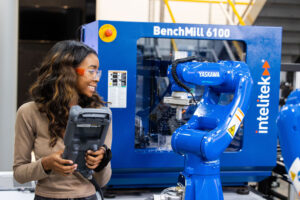As recently as 10 or 20 years ago, manufacturing was widely considered by school administrators and guidance counselors to be a career of last resort for students with few other options. Manufacturing jobs were moving overseas at an alarming rate. The job environment itself was noisy and dirty, and the opportunities for advancement were limited. But that’s all changing.
Manufacturing has rebounded in a big way in the United States, and skilled workers are now in high demand. What’s more, today’s manufacturing facilities are clean, modern, technologically advanced workplaces that offer many exciting opportunities for students to work with cutting-edge technologies.
Manufacturing gives students a viable pathway to high-growth, high-wage jobs—and if secondary schools aren’t including manufacturing in their career and technical education programs, they’re missing a key opportunity to prepare students for highly attractive careers.
Here are five reasons why middle and high schools should add manufacturing to their career education programs if they haven’t already.
- There’s a significant need for manufacturing employees.
As the New York Times reports, U.S. manufacturing is experiencing a big resurgence. Delivery delays, high shipping prices, and other supply chain issues during the pandemic have encouraged many companies to move production closer to home. New federal policies such as tax credits and infrastructure spending have also contributed to the boom.
Not only has the manufacturing sector fully recovered from the job losses experienced during the pandemic, but according to the U.S. Department of Labor, U.S. manufacturers have added some 300,000 jobs in the last year—and there are 550,000 job openings in manufacturing as of July 2023.
And the future outlook is bright as well: According to an analysis by McKinsey & Company, U.S. manufacturers could add another 1.5 million new jobs by 2030.
- Manufacturing jobs pay well.
Citing data from the federal Bureau of Labor Statistics, the National Association of Manufacturers reports that in 2021, manufacturing employees in the U.S. earned $95,990 per year, on average, including pay and benefits. That’s nearly $15,000 higher than the average annual earnings for all private (nonfarm) industries combined.
Even entry-level positions pay well. The estimated total pay for an entry-level manufacturing job in the U.S. is $67,272 per year, Glassdoor reports, with an average base salary of $57,201 per year and additional pay totaling $10,071.
- Students have several options for starting their career.
Many entry-level manufacturing jobs don’t require a four-year college degree. Students can often start their career with the training they receive in high school or an associate’s degree program. That’s good news for students who are worried about paying for college or who have no desire to attend a four-year university. Jobs in manufacturing require technically skilled candidates and include roles like installers, operators, maintenance technicians and integrators.
- The opportunities for career advancement are plentiful.
Although many entry-level positions don’t require a college degree, there are several advancement opportunities for enterprising workers. Students might start out as system operators or production technicians, but with additional training and education, they can advance into roles such as production manager or designer—where they would be in charge of overseeing operations or designing key manufacturing processes. The average production manager salary in the United States is just over $117,000 and can range up to $150,000 with experience.
- Manufacturing offers an exciting and fulfilling work environment.
Today’s manufacturing jobs involve the use of modern technologies to improve quality, productivity, and safety. Students who like to learn about and use technology will find numerous opportunities to do so in a manufacturing career, getting hands-on experience with tools such as robotics, 3D printing, smart sensors, and data analytics.
In addition, there’s something deeply satisfying about making something tangible that you can use. Depending on where students work, they might be making products used in everyday life or devices used to help people in advanced fields such as health care or electronics.
A highly resurgent field
Today’s manufacturing environments are very different from those experienced by previous generations. With manufacturing coming back and in need of workers who are skilled in modern tools and processes, schools should be sure to communicate these opportunities to their students—and career education programs should prepare interested students for jobs in this highly resurgent field.

























